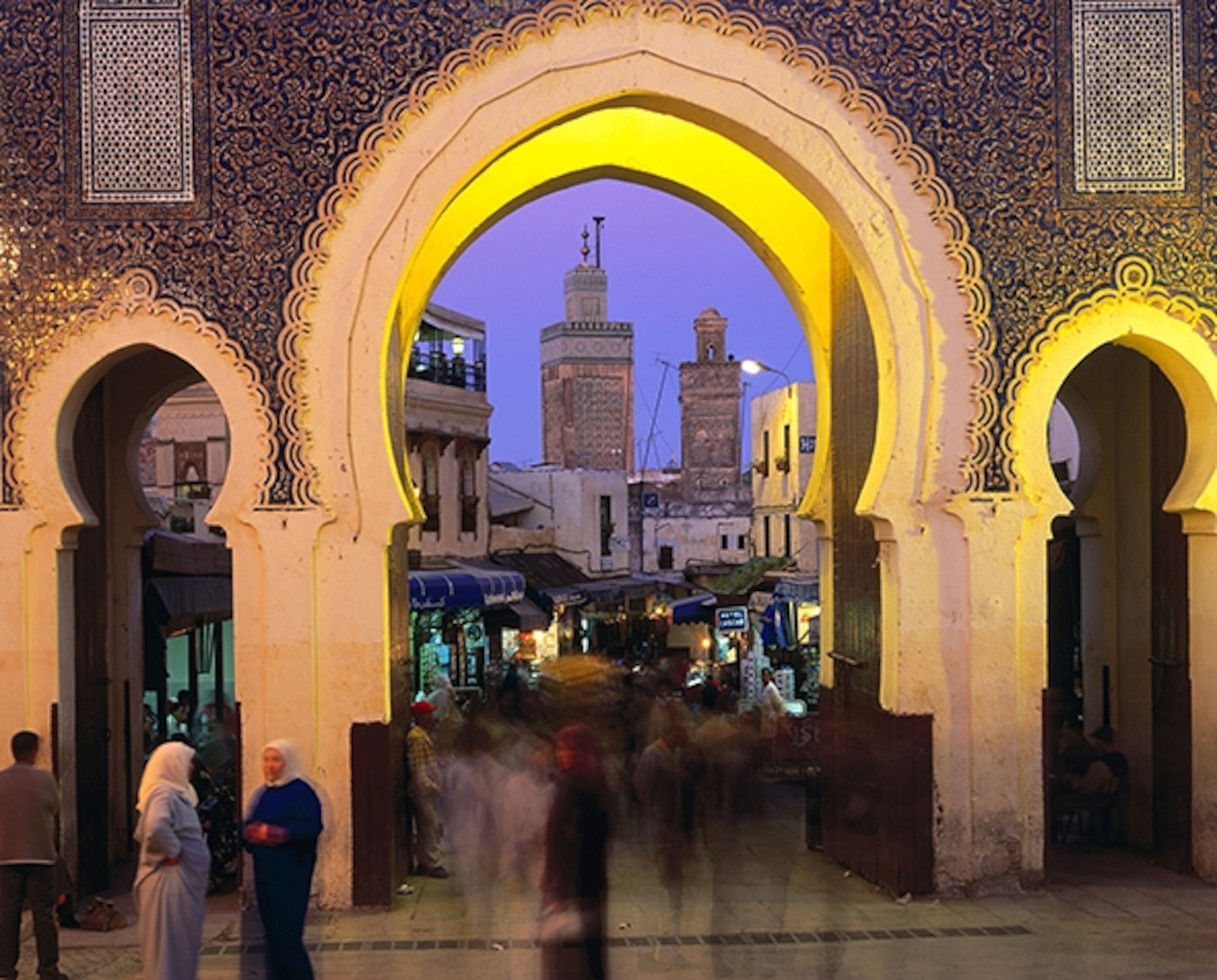
Hamza’s Fez
Fez native Hamza El Fasiki is a jack of all trades. The social entrepreneur, artist (he learned the traditional art of tea-tray etching from his father), musician (he plays a mean
oud
), and academic (he holds a master’s degree in Moroccan culture) has been led by his interests all around the world. Though Hamza has spent time in the United States, Japan, Greece, Turkey, Algeria, and the United Arab Emirates, nothing can compare to his hometown. Here are a few of his favorite things about the “Athens of Africa.”Fez Is My City
When someone comes to visit me, the first place I take them to is Fez’s impressive medina and the Bab Boujloud, a massive gate built by the French in the early 1900s. The original 12th-century gate, or bab, that once served as an entryway to the medina can be admired nearby.
October is the best time to visit my city because Fez celebrates the anniversary of its founder, Moulay Idriss II. The whole city beams with happiness, celebrating several rituals that can be witnessed in the streets and inside houses.
You can see my city best from Borj Nord (Northern Tower) or Borj Sud (Southern Tower). Both are centrally located and accessible by foot or taxi.
Nejjarine Square and Souk el Henna are the places to buy authentic, local souvenirs.
In the past, notable people like historian/sociologist Ibn Khaldoun and North African geographer Leo Africanus have called my city home.
My city’s best museum is the Medersa Bou Inania. Though a school, the structure beautifully illustrates the life of 13th-century students who attended classes at al-Qarawiyyin, the oldest continually operating university in the world. Enjoy the architecture, huge minaret, and kind elderly people praying inside.
The best place to spend time outdoors in my city is in the Jnan Sbil garden, a marvelous Andalusian public park.
My city really knows how to celebrate music because every June it hosts the World Sacred Music Festival. Fez becomes a meeting point like no other for a variety of Sufi and spiritual musicians from all over the world.
You can tell if someone is from my city if they never lose their way navigating Fez’s narrow alleys.
For a fancy night out, I recommend attending one of the Sunday Sunset Concerts at Café Clock, which hosts Gnawa musicians every week.
Just outside my city, you can visit Ifrane, a small town often referred to as the Switzerland of Morocco, or Sefrou, where you can get a taste of local artisanal life through a tour or workshop with Culture Vulture.
My city is known for being the city of knowledge in Morocco, but it’s really the city of handicraft.
The best outdoor market in my city is Talaa Kebira where you can find traditional slippers, clothes, post cards, and even local fast food like couscous.
To find out what’s going on at night and on the weekends, read The View From Fez blog.
When I’m feeling cash-strapped, I hang out with friends in Boujloud Square and peruse interesting objects at the flea markets.
To escape the crowds, I go to my father’s shop, known as Craft Draft, in the merchant warehouse Funduq El Kherachfiyeen. There, travelers can meet artisans and learn about the art of engraving tea trays and the history of copper-smithing in Fez. Visitors can even etch a simple, local design on a tea tray to take home.
Mint tea with orange blossom is my city’s signature drink. Sample it at Café Clock and Souk Al-Henna.
If you’re in the mood to dance, check out a concert at the ALC-ALIF Music Club.
- National Geographic Expeditions
Eating an orange while in a public bath house—and sharing said orange with the stranger next to you—could only happen in my city.
In the summer you should visit Chouara Tannery.
In the fall you should spend some time in the northern Moroccan town Moualy Idriss Zerhoun, the spiritual home of Moulay Idriss I, the father of Fez’s founder.
In the winter you should grab a camera and capture the changing colors of the city’s walls.
If you have kids (or are a kid at heart), you won’t want to miss storytelling sessions at Café Clock. The Hikayat Project invites locals and tourists to enjoy traditional stories like those in One Thousand and One Nights.
The best book about my city is The History and Description of Africa, by Leo Africanus. Available in Italian, Arabic, English, and French, this book describes the markets, handicrafts, and lifestyles of the Fassi people (Fez natives). Although old, the magic lies in the fact that most of what is described can still be found in the city today.
The world should heart my city because Fez invites you to travel through history from the 9th century on. It’s a maze, a living museum, and an astonishing craft mecca, all in one.





